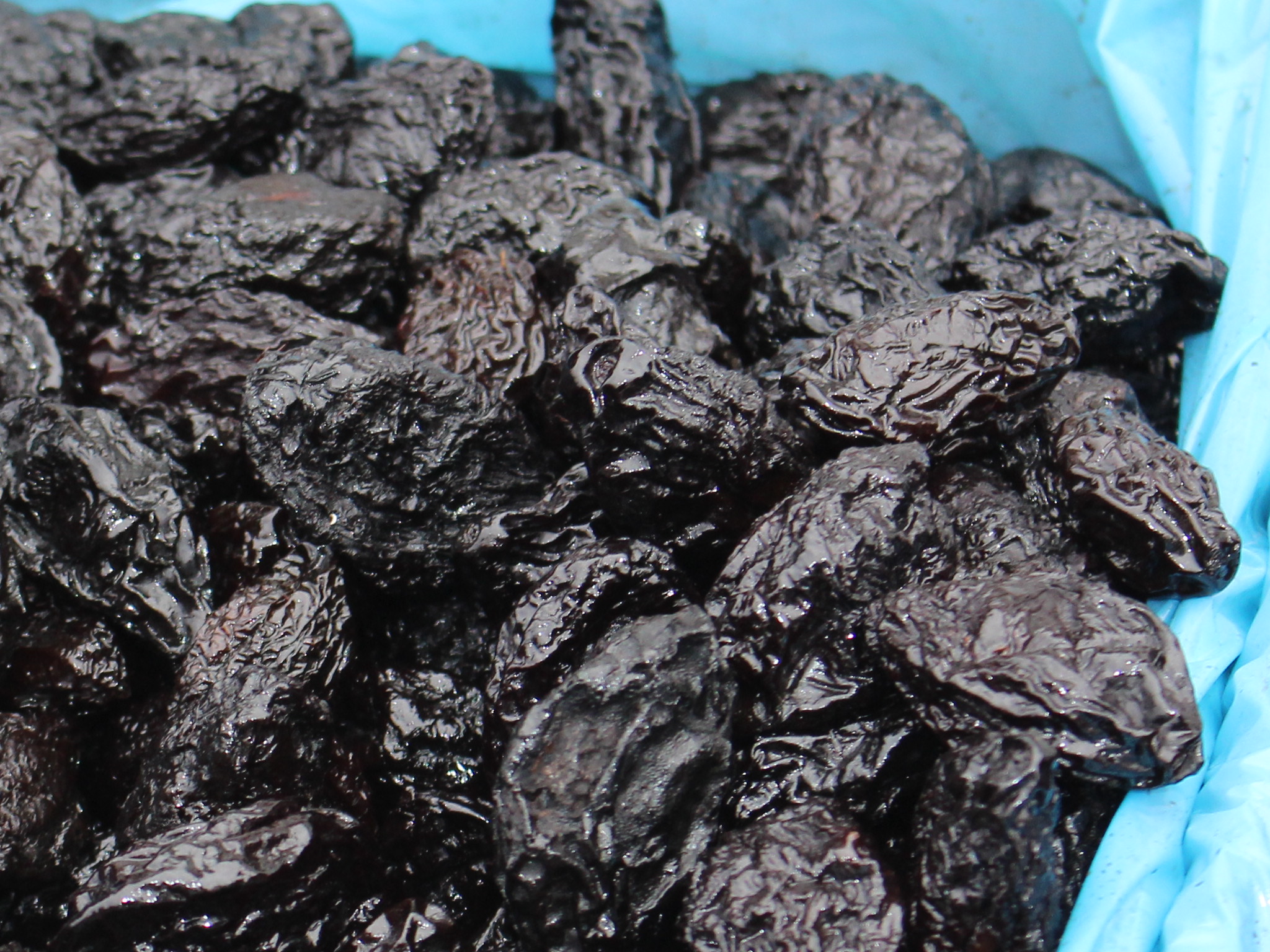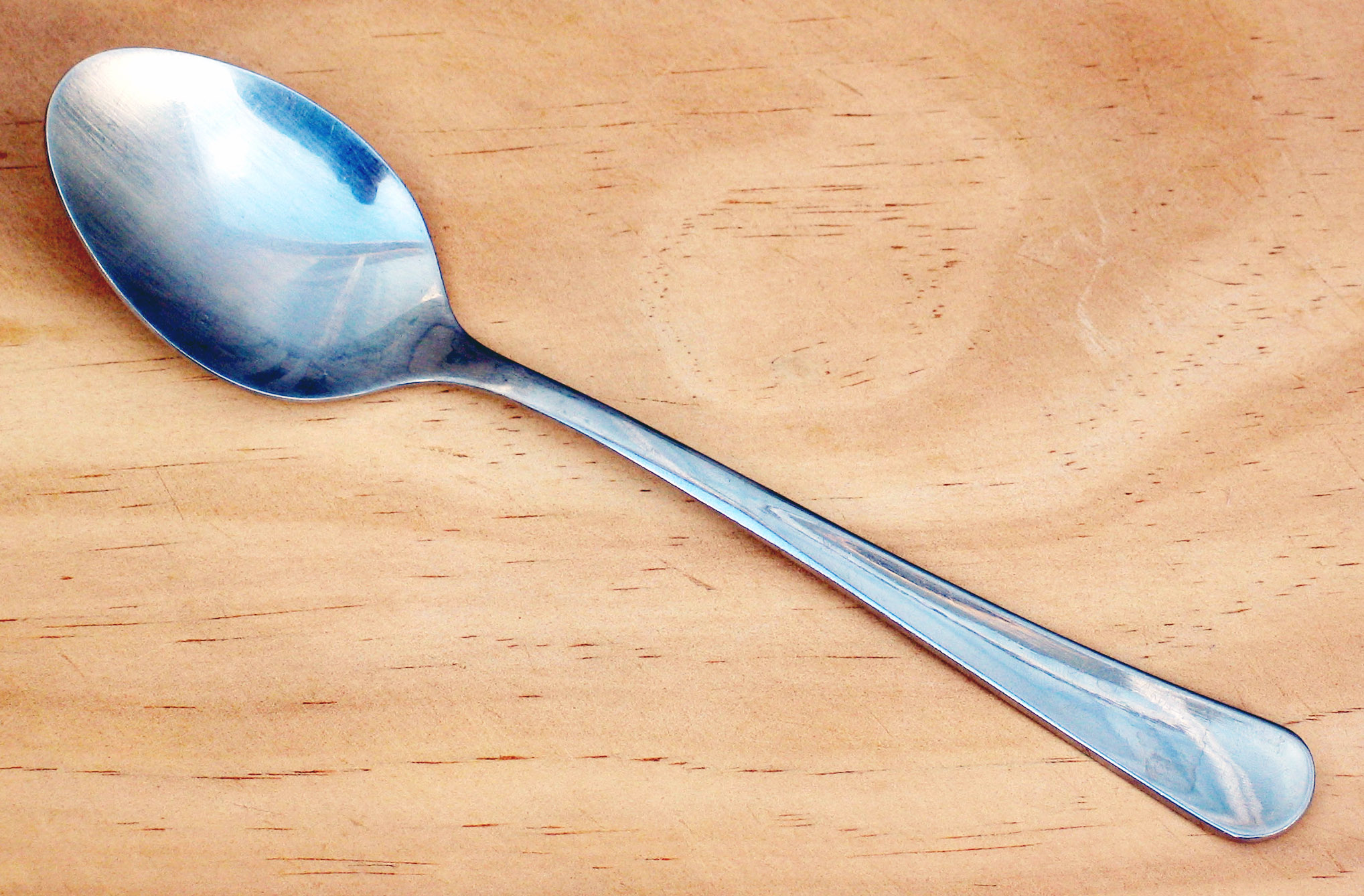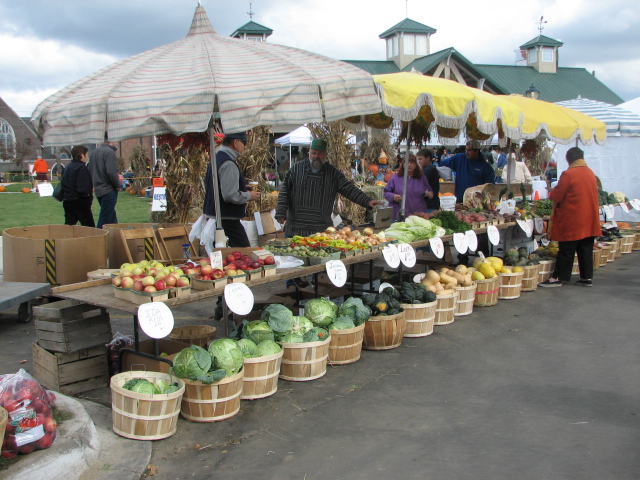|
Mote Con Huesillo
Mote con huesillo is a traditional Chilean summer-time drink often sold in street stands or vendor carts. It is a non-alcoholic beverage consisting of a sweet clear nectar-like liquid made with dried peaches (huesillo) cooked in sugar, water and cinnamon, and then once cooled, mixed with fresh cooked husked wheat berries (mote). The sweet clear nectar is usually made with sugar, but can also be supplemented or replaced with molasses. When the drink is served without the dried peaches, it is called a "descarozados". On occasion, it may also be served with dried prunes, however this is less common. Another modern option is to use peach preserves in place of the dried peaches. Both the mote and huesillo correspond to Mediterranean climates, like that of central Chile. This drink is very popular during summer months and is sold by street vendors on rolling carts or stands. It is also a very popular homemade recipe, for which the ingredients are readily available in supermarkets, s ... [...More Info...] [...Related Items...] OR: [Wikipedia] [Google] [Baidu] |
Chile
Chile, officially the Republic of Chile, is a country in the western part of South America. It is the southernmost country in the world, and the closest to Antarctica, occupying a long and narrow strip of land between the Andes to the east and the Pacific Ocean to the west. Chile covers an area of , with a population of 17.5 million as of 2017. It shares land borders with Peru to the north, Bolivia to the north-east, Argentina to the east, and the Drake Passage in the far south. Chile also controls the Pacific islands of Juan Fernández, Isla Salas y Gómez, Desventuradas, and Easter Island in Oceania. It also claims about of Antarctica under the Chilean Antarctic Territory. The country's capital and largest city is Santiago, and its national language is Spanish. Spain conquered and colonized the region in the mid-16th century, replacing Inca rule, but failing to conquer the independent Mapuche who inhabited what is now south-central Chile. In 1818, after declaring in ... [...More Info...] [...Related Items...] OR: [Wikipedia] [Google] [Baidu] |
Prunes
A prune is a dried plum, most commonly from the European plum (''Prunus domestica''). Not all plum species or varieties can be dried into prunes. A prune is the firm-fleshed fruit (plum) of ''Prunus domestica'' varieties that have a high soluble solids content, and does not ferment during drying. Use of the term "prune" for fresh plums is obsolete except when applied to varieties of plum grown for drying. Most prunes are ''freestone'' cultivars (the pit is easy to remove), whereas most plums grown for fresh consumption are ''clingstone'' (the pit is more difficult to remove). Prunes are 64% carbohydrates including dietary fiber, 2% protein, a rich source of vitamin K, and a moderate source of B vitamins and dietary minerals. The sorbitol content of dietary fiber likely provides the laxative effect associated with consuming prunes. Contrary to the name, boiled plums or prunes are not used to make sugar plums. Production More than 1,000 plum cultivars are grown for drying. T ... [...More Info...] [...Related Items...] OR: [Wikipedia] [Google] [Baidu] |
Dessert Spoon
A dessert spoon is a spoon designed specifically for eating dessert and sometimes used for soup or cereals. Similar in size to a soup spoon (intermediate between a teaspoon and a tablespoon) but with an oval rather than round bowl, it typically has a capacity around twice that of a teaspoon. By extension, the term 'dessert spoon' is used as a cooking measure of volume, usually of 10ml or fl oz. Dining The use of dessert spoons around the world varies greatly; in some areas they are very common, while in other places the use of the dessert spoon is almost unheard of—with diners using forks or teaspoons for their desserts instead. In most traditional table settings, the dessert spoon is placed above the plate or bowl, separated from the rest of the cutlery, or it may simply be brought in with the dessert. Culinary measure As a unit of culinary measure, a level dessertspoon (''dstspn.'') equals 2 teaspoons. In the United States this is of a fluid ounce. In the UK it is 10 m ... [...More Info...] [...Related Items...] OR: [Wikipedia] [Google] [Baidu] |
Caramelize
Caramelization is a process of browning of sugar used extensively in cooking for the resulting sweet nutty flavor and brown color. The brown colors are produced by three groups of polymers: caramelans (C24H36O18), caramelens (C36H50O25), and caramelins (C125H188O80). As the process occurs, volatile chemicals such as diacetyl are released, producing the characteristic caramel flavor. Like the Maillard reaction, caramelization is a type of non-enzymatic browning. Unlike the Maillard reaction, caramelization is pyrolytic, as opposed to being a reaction with amino acids. When caramelization involves the disaccharide sucrose, it is broken down into the monosaccharides fructose and glucose. Process Caramelization is a complex, poorly understood process that produces hundreds of chemical products, and includes the following types of reactions: * equilibration of anomeric and ring forms * sucrose inversion to fructose and glucose * condensation reactions * intramolecular bond ... [...More Info...] [...Related Items...] OR: [Wikipedia] [Google] [Baidu] |
Hydrate
In chemistry, a hydrate is a substance that contains water or its constituent elements. The chemical state of the water varies widely between different classes of hydrates, some of which were so labeled before their chemical structure was understood. Chemical nature Inorganic chemistry Hydrates are inorganic salts "containing water molecules combined in a definite ratio as an integral part of the crystal" that are either bound to a metal center or that have crystallized with the metal complex. Such hydrates are also said to contain ''water of crystallization'' or ''water of hydration''. If the water is heavy water in which the constituent hydrogen is the isotope deuterium, then the term ''deuterate'' may be used in place of ''hydrate''. A colorful example is cobalt(II) chloride, which turns from blue to red upon hydration, and can therefore be used as a water indicator. The notation "''hydrated compound''⋅''n''", where ''n'' is the number of water molecules per formula un ... [...More Info...] [...Related Items...] OR: [Wikipedia] [Google] [Baidu] |
Mote Con Huesillos En Venta
A mote is a small bit of substance, such as a fleck or particle. Mote may also refer to: Art and entertainment * The Motes, a Canadian indie-rock band active in the 1990s * "Mote", a song by Sonic Youth from their 1990 album '' Goo'' * "Mote", a song by The Faint on the 2001 vinyl EP recording '' Mote/Dust'' * Mote, a fairy character in ''A Midsummer Night's Dream'' * The Mote and the Beam, a parable * ''The Mote in God's Eye'', a science fiction novel Other uses * Mote (name) (including a list of people with the name) * Mote (food), various types of cooked grains consumed in South America * Mote con huesillo, a non-alcoholic drink from Chile * Mote spoon, a type of spoon used when preparing tea * Mote (sensor) A sensor node, also known as a mote (chiefly in North America), is a node in a sensor network that is capable of performing some processing, gathering sensory information and communicating with other connected nodes in the network. A mote is a no ..., a node in a wire ... [...More Info...] [...Related Items...] OR: [Wikipedia] [Google] [Baidu] |
Farmers' Market
A farmers' market (or farmers market according to the AP stylebook, also farmer's market in the Cambridge Dictionary) is a physical retail marketplace intended to sell foods directly by farmers to consumers. Farmers' markets may be indoors or outdoors and typically consist of booths, tables or stands where farmers sell their produce, live animals and plants, and sometimes prepared foods and beverages. Farmers' markets exist in many countries worldwide and reflect the local culture and economy. The size of the market may be just a few stalls or it may be as large as several city blocks. Due to their nature, they tend to be less rigidly regulated than retail produce shops. They are distinguished from public markets, which are generally housed in permanent structures, open year-round, and offer a variety of non-farmer/non-producer vendors, packaged foods and non-food products. History The current concept of a farmers' market is similar to past concepts, but different in relatio ... [...More Info...] [...Related Items...] OR: [Wikipedia] [Google] [Baidu] |
Central Chile
Central Chile (''Zona central'') is one of the five natural regions into which CORFO divided continental Chile in 1950. It is home to a majority of the Chilean population and includes the three largest metropolitan areas—Santiago, Valparaíso, and Concepción. It extends from 32° south latitude to 37° south latitude. Geography Central Chile is one of the five main geographical zones in which Chile is divided. The Chilean Central Valley lies between the coastal range ("Cordillera de la Costa") and the Andes Mountains. To the north is the semi-desert region known as El Norte Chico, (the "little north"), which lies between 28° and 32° south latitude. To the south lies the cooler and wetter Valdivian temperate rain forests ecoregion, in Los Lagos Region; (the latter includes most of South America's temperate rain forests). The Central valley is a fertile region and the agricultural heartland of Chile. Climate The climate is of the temperate Mediterranean type, with t ... [...More Info...] [...Related Items...] OR: [Wikipedia] [Google] [Baidu] |
Mediterranean Climate
A Mediterranean climate (also called a dry summer temperate climate ''Cs'') is a temperate climate sub-type, generally characterized by warm, dry summers and mild, fairly wet winters; these weather conditions are typically experienced in the majority of Mediterranean-climate regions and countries, but remain highly dependent on proximity to the ocean, altitude and geographical location. This climate type's name is in reference to the coastal regions of the Mediterranean Sea within the Mediterranean Basin, where this climate type is most prevalent. The "original" Mediterranean zone is a massive area, its western region beginning with the Iberian Peninsula in southwestern Europe and coastal regions of northern Morocco, extending eastwards across southern Europe, the Balkans, and coastal Northern Africa, before reaching a dead-end at the Levant region's coastline. Mediterranean climate zones are typically located along the western coasts of landmasses, between roughly 30 and 45 ... [...More Info...] [...Related Items...] OR: [Wikipedia] [Google] [Baidu] |
Preserves
Fruit preserves are preparations of fruits whose main preserving agent is sugar and sometimes acid, often stored in glass jars and used as a condiment or spread. There are many varieties of fruit preserves globally, distinguished by the method of preparation, type of fruit used, and place in a meal. Sweet fruit preserves such as jams, jellies, and marmalades are often eaten at breakfast with bread or as an ingredient of a pastry or dessert, whereas more savory and acidic preserves made from " vegetable fruits" such as tomato, squash or zucchini, are eaten alongside savory foods such as cheese, cold meats, and curries. Techniques There are several techniques of making jam, with or without added water. One factor depends on the natural pectin content of the ingredients. When making jam with low pectin fruits like strawberries either high pectin fruit like orange can be added, or additional pectin in the form of pectin powder, citric acid or citrus peels. Often the fruit will be ... [...More Info...] [...Related Items...] OR: [Wikipedia] [Google] [Baidu] |
Molasses
Molasses () is a viscous substance resulting from refining sugarcane or sugar beets into sugar. Molasses varies in the amount of sugar, method of extraction and age of the plant. Sugarcane molasses is primarily used to sweeten and flavour foods. Molasses is a major constituent of fine commercial brown sugar. It is also one of the primary ingredients used to distill rum. Sweet sorghum syrup is colloquially called ''sorghum molasses'' in the southern United States. Molasses has a stronger flavour than most alternative syrups. Name The word molasses comes from ''melaço'' in Portuguese, a derivative (intensifier) of ''mel'' (honey) with Latinate roots. Cognates include Ancient Greek μέλι (''méli'') (honey), Latin ''mel'', Spanish ''melaza'' (molasses), Romanian ''miere'' or ''melasă'', and French ''miel'' (honey). Cane molasses Cane molasses is an ingredient used in baking and cooking. It was popular in the Americas before the twentieth century, when it was plentiful and ... [...More Info...] [...Related Items...] OR: [Wikipedia] [Google] [Baidu] |
Non-alcoholic Beverage
An alcohol-free or non-alcoholic drink, also known as a temperance drink, is a version of an alcoholic drink made without alcohol, or with the alcohol removed or reduced to almost zero. These may take the form of a non-alcoholic mixed drink (a "virgin drink" or "mocktail") or non-alcoholic beer ("near beer"), and are widely available where alcoholic drinks are sold. Scientific definition Low-alcoholic drink Sparkling apple cider, soft drinks, and juice naturally contain trace amounts or no alcohol. Some fresh orange juices are above the UK 'alcohol free' limit of 0.05% ABV, as are some yogurts and rye bread. Ethanol distillation is used to separate alcoholic drinks into what are advertised as non-alcoholic drinks and spirits. Distilled wine produces low alcohol wine and brandy (from brandywine, derived from Dutch ''brandewijn'', "burning wine"). Distilled beer may be used to produce low-alcohol beer and whisky. However, alcoholic drinks cannot be further purified to 0.00% alco ... [...More Info...] [...Related Items...] OR: [Wikipedia] [Google] [Baidu] |



_chloride.jpg)


